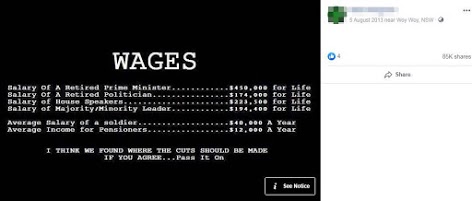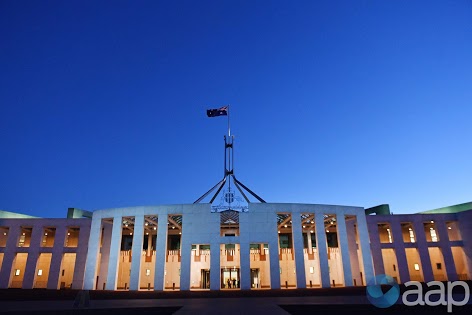The Statement
AAP FactCheck examined a Facebook post from August 5, 2013 by an Australian user which features the purported salaries of politicians compared to soldiers and pensioners.

The post reads: “WAGES
Salary Of A Retired Prime Minister………………$450,000 for life
Salary Of A Retired Politician…………………….$174,000 for life
Salary of House Speakers………………………..$223,500 for life
Salary of Majority/Minority Leader……………….$194,000 for life
Average Salary of a soldier……………………….$40,000 a year
Average Income for Pensioners………………….$12,000 a year
I THINK WE FOUND WHERE THE CUTS SHULD BE MADE IF YOU AGREE…Pass It On”
The post has been shared on Facebook more than 85,000 times.
The Analysis
Australian federal politicians have access to two pension systems when they retire based on when they were elected to parliament. Those who entered parliament before October 9, 2004 get access to the Parliamentary Contributory Superannuation Scheme (PCSS) after they retire.
The PCSS was introduced in 1948 and pays retired politicians, who were elected to parliament before October 9, 2004, a retirement income based on the number of years they have served in parliament – a percentage from 80 per cent of an MP’s base salary (Remuneration Tribunal (Members of Parliament) Determination 2019 Compilation No.1, page 3) . If a politician has served in other ministerial roles during their tenure, 6.25 per cent of 80 per cent of the salary for that role is included for every additional role the politician held. The extra money from ministerial roles is capped at 75 per cent of the highest paid additional role the politician held.
A Department of Finance spokesperson told AAP FactCheck politicians who “entered the parliament after 9 October 2004, which constitutes more than 90 per cent of federal parliamentarians, are not entitled to a pension on retirement”. For those who are eligible, the pension varies from politician to politician and the base salary is revised every year by the Remuneration Tribunal.
The Remuneration Tribunal is an “independent statutory authority established under the Remuneration Tribunal Act 1973” with a purpose to “determine, report on or provide advice about remuneration, including allowances and entitlements” for federal Parliamentarians, judicial and non-judicial offices of federal courts and tribunals Secretaries of Departments, full-time and part-time holders of various public offices and Principal Executive Offices.
The PCSS was closed to new members after October 9, 2004. Politicians who enter parliament after that time are subject to the Parliamentary Superannuation Act 2004 which sees 15.4 per cent of their salary contributed to a super fund.
The Finance Department spokesperson told AAP FactCheck federal politicians who entered parliament following the changes in 2004 are “members of superannuation schemes that are common throughout the community.”
“Under these schemes, the superannuation benefit is payable as a lump sum, consisting of accumulated contributions and earnings,” the spokesperson said. “Access to these benefits is subject to the same conditions that apply to the broader community.”
The post quotes incorrect figures for retired Australian prime ministers and federal politicians. Based on a Remuneration Tribunal determination that came into force on 1 July, a retired prime minister could potentially earn up to $328,162 for life, while an ex-MP would be entitled to a minimum pension of $125,362. Some politicians who entered federal parliament before October 9, 2004 would receive more than the minimum if they served as ministers or as other office-holders.
For example Julie Bishop, Christopher Pyne and Nigel Scullion will receive at least $188,000 a year for the rest of their life, according to a report in the Sydney Morning Herald. Steve Ciobo, 44, who was elected to federal parliament in 2001, would also be eligible for a pension but can only begin receiving payment when he turns 55. This is due to changes made by the Howard government where those elected between November 10, 2001 to October 9, 2004 would become eligible once they turn 55.
In 2013, the year of the post examined by AAP FactCheck, the Speaker of the House of Representatives and the President of the Senate president each received a salary of $341,477.50 from a base salary of $195,130 with an additional 75 per cent of that base salary for those positions added on. In 2019, both positions received a salary of $369,687.50 from a base salary of $211,250 and the 75 per cent addition for the role.
The Speaker of the House of Representatives and the President of the Senate do not stay on the salaries for those positions “for life”. Once they retire, they move onto the retirement scheme based on when they were elected to parliament.
Unlike the US political system, the Australian system does not have an equivalent role for a Majority and Minority leader in parliament. The most comparable role in the Australian parliament for a majority leader is the prime minister, the leader of a party who controls more than half of the seats in the House of Representatives and, therefore, forms government.
In 2013, the prime minister of Australia had a salary of $507,338 from a base salary of $195,130 with an additional 160 per cent added on. In 2019, the prime minister earns a salary of $549,250 from a base salary of $211,250 with a 160 per cent of that base added on.
The Leader of the Opposition earns, as of 2019, $390,812.5 a year from a base salary of 211,250 and an additional 85 per cent for holding the position of leader of the opposition, compared to $360,990 in 2013.
The Department of Finance lists the Leader of a Minority Party under two definitions: with more than 10 members in parliament and with up to 10 members in parliament. The second definition may refer to leaders of minor parties, such as The Australian Greens or One Nation, who have fewer than 10 elected members in parliament and earned a salary of $301,031 in 2019 – an additional 42.5 per cent on top of the base salary.
In 2013, leaders of minor parties who had more than five members of parliament but fewer than 10 earned $278,060.25.
The leaders of these minor parties do not, however, stay on this salary for life and revert to superannuation schemes when they retire. The amount their receive will vary based on when they were elected to parliament and how long they served in parliament. The Department of Finance told AAP FactCheck the post’s claim that the listed politicians receive their salaries “for life” is untrue.
Australian soldiers currently serving in the Australian Defence Force can earn between $48,990 and $55,762 on completion of military and employment training.
The age to receive the aged pension is increasing from 65 to 67 over eight years. From July 1, 2019, people are able to start receiving a pension once they turn 66 and are eligible for the pension if they earn less than $2040.80 a fortnight. Pensioners must satisfy the income and assets tests to start receiving the aged pension. Based on the income test, those who earn more than $174 per fortnight will have their pension reduced by 50 cents for every dollar over $174. If they receive an income of $2040.80, they will no longer receive a pension payment.
Based on the assets test, the pension rate begins to reduce if a pensioner owns assets worth more than $263,250 for a single person who is a home owner. A single person and homeowner receiving a part pension stops receiving the payment once their assets are worth more than $574,500. A single pensioner on a full aged pension income would receive $933.40 a fortnight, from a maximum basic rate of $850.40, $68.90 pension supplement and a $14.10 energy supplement. Single pensioners on the full pension would receive $22,401.60 a year. However, pensioners could get a part pension based on their retirement savings which could reduce the amount of pension money they receive based on the income test and/or assets test.
The Verdict
Based on the evidence, AAP FactCheck found the Facebook post to have a mixture of true and false claims. It is not true the listed salaries for politicians are “for life” as the Department of Finance confirmed to AAP FactCheck.
The pension will vary in the case of each federal politician and depend on what other roles they have served during their time in parliament. The base salary of a politician determines how much they receive as a pension. It is up to the Remuneration Tribunal to set the base salary for politicians. Politicians elected after October 9, 2004 contribute to a superannuation fund like other Australian workers.
Partly False – The claim of the content is a mixture of accurate and inaccurate, or the primary claim is misleading or incomplete.
First published November 8, 2019, 15:35 AEDT
Updated February 16, 2021 16:06 AEDT – Corrects figures in references to prime minister’s potential maximum pension entitlement and pension entitlements for MPs.
Updated June 6, 2022 16:10 AEST – Removes fifth paragraph relating to retired prime ministers and access to the PCSS pension system.


















